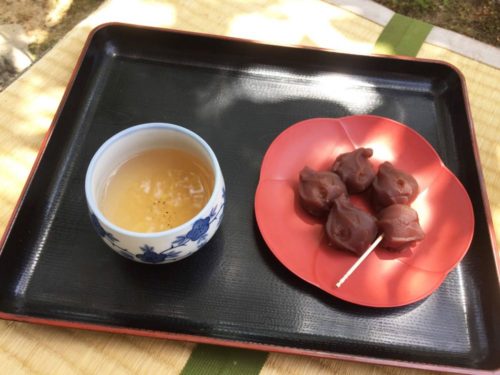Wagashi are Japanese sweets that look more like a piece of art than something to eat. What is the history of these beautiful sweets, and what is actually inside them?



History
Wagashi have a very long history that goes back to more than 2000 years ago. The people in ancient Japan used to grind nuts to powder and stomp rice until it became one sticky whole; these were the beginnings of what are known as dango and mochi today.
Wagashi have been influenced by Chinese styles, the development of the tea ceremony, and later by Western styles. It was, however, especially in the Edo period (1603-1868) that wagashi have improved significantly in quality as the period of isolation from the rest of the world made Japan refine its inner culture, and it was also a time of relative peace.
Nowadays, wagashi are produced all over Japan. Although it is often the inhabitants of Kyoto who are the proudest of their very beautiful creations. There are regional differences in wagashi characteristics and ingredients, but the most used ingredients are red bean paste (anko) and rice cake (mochi).
Wagashi Design
The design of Wagashi tends to feature the natural beauty that is distinctive to the season we are in. For example, in spring when cherry blossoms are in full bloom, wagashi confectioners produce sweets in the shape of cherry blossoms or use cherry petals or leaves in their product. Each wagashi is named after a beautiful seasonal object or phenomenon or after a word from a famous poem verse or ancient literature. When people hear such a poetic name, they can use their imagination to depict the natural scenery that would come with it.
Different Flavors
About the sense of taste, wagashi shouldn’t taste too sweet or too plain. This is because we should make a fine balance between the sweetness of confectionery and the bitterness of the matcha tea that is very often accompanied by wagashi. For a similar reason, wagashi’s fragrance is rather subtle in order not to disturb the understated fragrance of the matcha tea.
Wagashi’s texture should also be appreciated by touching it with the hand or placing it in the mouth. This way, all senses are used while enjoying wagashi.
Types of Wagashi
It is easy to see how truly diverse wagashi can be. However, for the sake of reference, Wagashi can be generally classified as follows.
- Mochimono (a confection made with rice mochi): Kashiwamochi, Daifuku, Ohagi, etc.
- Mushimono (a confection made by steaming): Mushimanju, Kurimushiyokan, etc.
- Yakimono (a confection made by baking; includes types that are cooked on a copper plate called a hiranabe and types baked in an oven) Hiranabemono: Dorayaki, Sakuramochi, etc. ・Obunmono: Kurimanju, Castella, etc.
- Nagashimono (a confection made by pouring ingredients into a mold): Yokan, etc.
- Nerimono (a confection made by shaping bean paste): Nerikiri, Konashi, etc.
- Okamono (a confection made by combining separate ingredients): Monaka, etc.
- Uchimono (confection that is placed in a mold and hardened through beating): Rakugan, etc.
Modern Wagashi
Wagashi has been elevated to the level of art that represents the essence of Japanese culture. This is because it has been developed together with the tea ceremony. Wagashi are mostly made with natural ingredients, which makes them much healthier than typical western sweets. Even for non-adventurous eaters, tasting a wagashi while in Japan should feature on your agenda, as they are not just beautiful but very tasty as well.


Your Japan Tour
As seasoned Japan experts, we create perfect Japan package tours including local delicacies. Check out our group tours and private tours, or contact us to start planning your unforgettable holiday to this fascinating country full of once-in-a-lifetime experiences, culture, history, nature, and delicious food!

